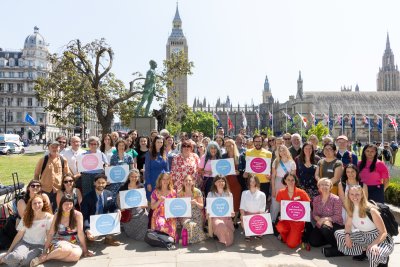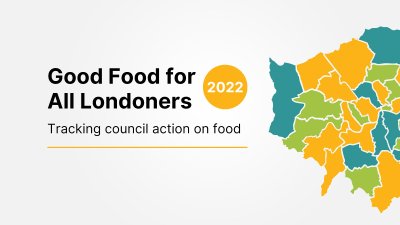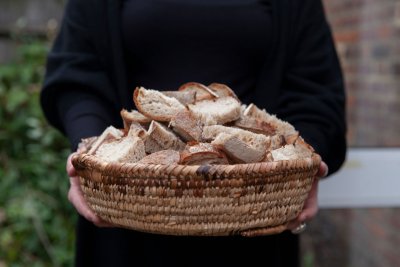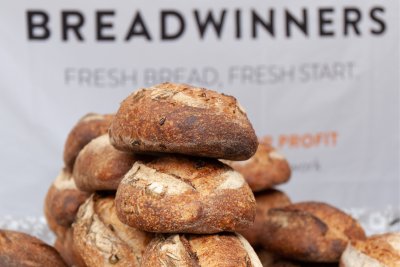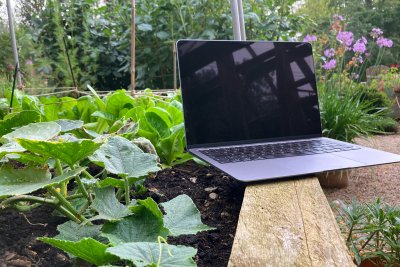London Food Link's response to the revision of the London Plan
Contents
1. About London Food Link
2. Why should the London Plan incorporate food?
3. Planning and food
4. Places and people
5. The economy
6. Climate change
7. Lifestyle
8. Photos
1. About London Food Link
London Food Link (LFL) runs a network of organisations and individuals who want to make London's food system more sustainable. Membership includes farmers, food writers, caterers and community food projects. The specific aims of LFL are to increase the availability of sustainable food in London, tackle the barriers preventing access to healthy and sustainable food for Londoners and to protect and celebrate London's diverse food culture. LFL is part of Sustain: The alliance for better food and farming. This response is submitted following a consultation with colleagues and members of the London Food Link and represents the general, rather than detailed views of members of that network.
2. Why should the London Plan incorporate food?
The following summarises the impact of food on a variety of social, environmental and economic factors.
Climate change: Between 20-30% of UK greenhouse gas emissions result from our food system. In London, food creates 19 million tonnes of greenhouse gas emissions per year – more than from all of London's transport, or all of London's houses.
Health: Diet-related illnesses cost the NHS £7.7 billion per year. In London, 23% of women and 18% of men are obese and a further third are classified as overweight .
Community well-being: A thriving local food system, including markets, food-growing and celebrations can contribute to community cohesion and overcome isolation.
Employment: In London the food and drink sector employs nearly 500,000 people and is the capital's second largest and fastest growing manufacturing sector. Some 80% of food manufacturing businesses employ fewer than 20 people, and around 25% of all London businesses sell food .
Waste: It is estimated that we throw away a third of the food we buy: London's food waste represents 6.3 million tonnes of greenhouse gases .
3. Planning and food
Planning affects the food system not only in how land for farming is used or protected, but also how food is bought and then disposed of. The Commission on Social Determinants of Health (WHO) recognises that our environments must be better designed to encourage healthy eating . Sustain has also published various reports on planning and food and influencing the London Plan is a key part of the London Food Strategy. Planning policy that includes food can:
- support jobs in the food sector (especially SMEs) by encouraging enterprises such as markets, and commercial food production in London and in the Green Belt. Employment initiatives may need to be combined with crime reduction policies (to protect businesses in deprived communities), and training in a range of food skills, including on health and sustainability, in order to achieve maximum benefits.
- improve access to food for deprived communities by ensuring sufficient diversity of food retail outlets across London, and within easy walking distance of communities. Diversity would include scale (small to large), ethnicity, and affordability.
- ensure green spaces in and around the capital are being used. This could increase the amount of food being grown and distributed in London by, for example, allotments, community growing spaces and a range of other under-utilised public and private space.
- reduce the GHG emissions, and increase food security. Food produced locally and in season, using sustainable growing methods such as organic, can reduce GHG emissions and reduce our reliance on “just-in-time” and oil-dependent supply chains.
Thus London Food Link believes food needs to be incorporated more centrally into the London Plan and also into London's housing, and economic development strategies. We propose that the London Plan includes the following four food policies and practices:
- Promoting (non-commercial) growing spaces, including allotments, in London for health and community benefit;
- Protecting the Green Belt and promoting commercial agriculture in and around London;
- Ensuring diverse food retail outlets across London, within easy walking distance of communities. The diversity should include scale, ethnicity and affordability and would incorporate support for street markets and farmers markets; and
- Developing sustainable food policies and practices in response to the challenge of climate change.
These are discussed in more detail in the following sections that relate to the London Plan.
4. Places and people
LFL agrees with the emphasis in the revised plan to support and develop the vibrancy of town centres and feel this has the potential to improve access to food for Londoners. As noted in the 2004 London Plan:
“The existence of thriving local convenience shopping is important, especially for less mobile people and those on low incomes for whom ready access to the components of a good diet are essential to support good health”.
In the UK it is estimated that four million people have difficulty obtaining a healthy diet, and food access is a challenge in many parts of London. Factors inhibiting good access to food include lack of accessible fresh food retail, transport costs to go shopping, poor quality produce, and a higher proportion of fast-food shops in low income areas. London's population is expected to rise and, according to the revised London Plan, 50,000 new houses are projected to be built. We are concerned that without specific planning guidance, food access problem may increase, so propose the following points should be incorporated into the Plan.
a) Ensure fresh food retailers are considered an essential facility (in much the same way as pharmacies are), and establish requirements in Local Development Plans to have fresh food shops within a designated distance of residents. Some boroughs do specify in their plans that shops (including food retailers) need to be within an estimated walking distance of residents. This should be supported by the London Plan.
b) Promote food mapping, both to assess the extent “food deserts” and to engage local communities in deciding what action needs to be taken, with council departments and the local NHS to tackle diet-related health inequalities.
c) Maintain and increase spaces for Londoners to grow their own food. Research shows that people who grow their own are more likely to eat more healthily and there is evidence to show that allotments and food growing has positive social, health, community, environmental and financial benefits . LFL is pleased to see the Revised Plan mention support for urban agriculture, and we propose that it specifically supports existing growing sites, the creation of new growing sites and a requirement for new housing to have growing sites for residents (see Lifestyle section for more detail.)
For example Camden PCT recently responded to a consultation on the Local Development Framework in the London Borough of Camden recommending that people (especially those on low incomes) should have more opportunity to grow their own food in allotments, market gardens, private gardens, small-holdings and city farms, and space should be allocated and protected for growing as well as encouraging a diversity of retail outlets including farmers' and street markets.
5. The economy
Food contributes substantially to London's economy and, as noted above and in the revised plan, is one of the fastest growing sectors of London's economy. We have seen whole areas of London regenerated through food (e.g. China Town and Brick Lane) and believe that the London Plan needs to encourage this in more areas by supporting commercial growing in London and the sustainable food sector in general.
a) Support commercial agriculture, especially in the Green Belt.
Stimulating the farming industry around and within London will encourage good use of existing Green Belt land and contribute to commercial viability and employment in London's outer areas. Local authorities can make a significant contribution to improving access to local and sustainably produced food, and to improving prospects for farmers, by protecting farm land and promoting its appropriate use – for example through the County Farm scheme and protection of Green Belt land for farming . Commercial growing is currently being researched by a committee in the London Assembly and the Mayor has also proposed launching an inquiry into London's planning system and commercial and non-commercial growing.
b) Support sustainable food businesses
We are encouraged to see support for farmers markets and street markets in the Plan and believe this will not only increase the commercial vibrancy of town centres, but also increase food access and support more local production. Planners also need to work alongside health and sustainability professionals and the police in high crime-areas to ensure that businesses can thrive and retailers are encouraged to provide healthy and sustainable options in their shops and on their menus. Planning incentives for local and sustainable food businesses could include: congestion charge concessions; rates holidays for neighbourhood shops or market stalls that sell fresh fruit and vegetables, thus providing an essential service; allowing vacant premises to be used for retailers or community food projects such as food co-ops, allocating temporary parking spaces for low-carbon delivery vehicles; increasing the number of public transport routes; and providing more public toilets.
For example Waltham Forest Council has recently used their LDF to prevent new fast-food restaurants from opening within a radius of 400m from schools, recognising the influence of high and easy availability of 'junk' foods on young people's diets .
6. Climate change
London's green house gas emissions from food and farming are greater than from all of London's houses and transport (see “Why should the London Plan incorporate food? above). Moreover 80% of Londoners' diets are from imported foods and this has serious implications for London's food security. While, in the long term, fossil fuel prices are likely to rise steeply, even in the immediate term oil and gas prices are very volatile. As food production costs, such as fertilisers and transport, are closely linked to fossil fuels, food has also become very vulnerable to price fluctuations which could, in turn, affect continuity of supply.
Ways to increase food security and meet carbon reduction targets, as well as mitigating the effects of climate change, could include the following:
a) Increasing the amount of food produced and processed in or near London
Support could be offered for commercial growing in the Green Belt, and non-commercial growing spaces in housing and offices, as well as encouraging edible plants to be grown in parks and fruit trees planted in the streets (see “Lifestyle” below, for more information).
For example London Borough of Enfield is exploring promotion of land for individuals, families and smallholders to engage in larger-scale production, supported by local authority land use policies and provision of horticulture training.
b) Composting
According to recent figures, a third of all food is thrown away and many councils are already collecting residential food waste. There is also a project currently under way, as part of the implementation of the London Food Strategy, to collect commercial waste for composting. The review of the London Plan mentions trying to keep all of London's waste in London. This could make sustainable compost available for commercial and non-commercial growers. Grey water irrigation could also be used for growing which would relax the strain on London's water supply.
7. Lifestyle
We are pleased to note that the Plan intends to support urban greening and urban agriculture and believe that The London Plan should seek to establish minimum standards for the provision of public open space through Borough Open Space Strategies. We would like to see the London Plan set standards for boroughs for:
a) Continued use of existing growing spaces such as allotments as well as other green land such as parks, which could be encouraged to grow food.
b) The number of sites that could be developed as green and growing sites (including roofs), include the land around public buildings such as hospitals, schools and care homes, and privately owned land, such as around canals and railways. As part of the Capital Growth project some growing spaces have been created by a group of students at SOAS near SOAS University in Camden, Cranbrook Community Food Garden for children and parents on an estate in Tower Hamlets, and by Brockwell Park Surgery with a plot for patients to use.
c) The creation of growing space allocated in new developments, offices and especially high density housing for allotments or communal growing.
30th June 2009
Suzanne Natelson
London Food Link Project Officer
Suzanne@sustainweb.org
Endnotes
1 London's Food Sector: Greenhouse Gas Emissions: A report for the Greater London Authority. (2008) https://www.sustainweb.org/pdf/food-emissions.rtf
2 Food Statistics Pocketbook 2008 Defra 2008 https://statistics.defra.gov.uk/esg/publications/pocketstats/foodpocketstats/FoodPocketbook2008.pdf
3 Healthy and Sustainable Food for London: The Mayor's Food Strategy (May 2006) http://www.london.gov.uk/mayor/health/food/docs/food-strategy.pdf
4 Healthy and Sustainable Food for London: The Mayor's Food Strategy (May 2006) http://www.london.gov.uk/mayor/health/food/docs/food-strategy.pdf
5 London's Food Sector: Greenhouse Gas Emissions. A report for the Greater London Authority. (2008) https://www.sustainweb.org/pdf/food-emissions.rtf
6 Closing the gap in a generation: Health equity through action on the social determinants of health, World Health Organization, 2008 http://www.who.int/social_determinants/thecommission/finalreport/closethegap_how/en/index1.html
7 Healthy and Sustainable Food for London: The Mayor's Food Strategy (May 2006) http://www.london.gov.uk/mayor/health/food/docs/food-strategy.pdf
8 The London Plan, Spatial Development Strategy for Greater London, GLA (2004)
9 Healthy and Sustainable Food for London: The Mayor's Food Strategy (May 2006) http://www.london.gov.uk/mayor/health/food/docs/food-strategy.pdf
10 How London's planners can improve access to healthy and affordable food: Guidance notes from the Food Strategy Unit of the London Development Agency. Prepared by The Food Commission (UK) and Sustain, The alliance for better food and farming.(2005)
11 Low Income diet and nutrition survey, Volume 3. (2009) On behalf of the Food Standards Agency http://www.food.gov.uk/multimedia/pdfs/lidnsvol03.pdf
12 A Lot to Lose: London's Disappearing Allotments (2006). Environment Committee, The London Assembly http://www.london.gov.uk/assembly/reports/environment.jsp
13 Good Food for Camden: The healthy and sustainable food strategy. Draft for consultation, December 2008 http://www.camden.gov.uk/ccm/navigation/council-and-democracy/having-your-say/consultations/
14 GLA 9th June 2009 Proposal for a Review of the Role of the Planning System in Supporting and Encouraging Commercial Food Growing in London; Report No. 7
15 Council bans takeaways near schools, 8th December 2008
http://www.thisislocallondon.co.uk/news/topstories/3958991.WALTHAM_FOREST__Council_bans_takeaways_near_schools/
16 GLA 9th June 2009 Proposal for a Review of the Role of the Planning System in Supporting and Encouraging Commercial Food Growing in London; Report No. 7
17 Personal correspondence with local authority representatives and Sustain, May 2009
18 WRAP website Household Food Waste http://www.wrap.org.uk/retail/food_waste/index.html 2009
19 Capital Growth is an initiative supported by the Mayor and managed by London Food Link. It's aim is to create 2,012 community growing spaces in London by 2012 and has seen a huge amount of interest from local community groups, businesses and councils. https://www.capitalgrowth.org/
Published Monday 13 July 2009
London Food Link: London Food Link brings together community food enterprises and projects that are working to make good food accessible to everyone in London to help create a healthy, sustainable and ethical food system for all.
